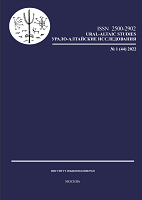ГРАММАТИЧЕСКАЯ СИСТЕМА ДО И ВО ВРЕМЯ ЯЗЫКОВОГО СДВИГА: ФОРМЫ БУДУЩЕГО ВРЕМЕНИ В УЛЬЧСКОМ ЯЗЫКЕ
GRAMMATICAL SYSTEM BEFORE AND UNDER LANGUAGE SHIFT: FUTURE TENSE FORMS IN ULCHA
Author(s): Natalia M. StoynovaSubject(s): Language studies, Theoretical Linguistics, Morphology, Semantics, Historical Linguistics
Published by: Институт языкознания Российской академии наук
Keywords: Tungusic languages; Ulcha; TAM categories; future tense; language shift; language attrition;
Summary/Abstract: In this paper, I discuss the system of future tense forms in Ulcha (Tungusic) in a language shift perspective. In Ulcha, the future semantic domain is covered by three main forms, i.e. two dedicated future tense forms and a present tense form. The first objective of the paper is to reconstruct the initial system of forms with reference to future (i. e. the system attested before the language shift). Based on data from early texts, I describe their distribution and competition within the future semantic domain. Three main forms compete in this domain. These are present forms, which are actively used in Ulcha both with reference to present and with reference to future, and two dedicated future tense forms. Both forms have additional modal semantic nuances. What is especially important for this study is that these forms are chosen on different grounds, therefore the range of contexts in which both forms are acceptable is quite wide. The second objective is to analyze how the use of future tense forms changes in a situation of language shift. This part of the study is based on comparative textual data (those coming from early archive texts and those coming from our recent field recordings), as well as on elicited data received from contemporary speakers. As expected, the frequency of non-specialized (present) forms increases, while the frequency of dedicated future tense forms becomes lower. At the same time, contrary to expectations, no notable semantic changes take place. Dedicated future tense forms are used by contemporary speakers more rarely, but exactly in the same contexts as before the language shift. I also consider a related morphological topic, i.e. regularization of the person-number paradigm in one of the future forms. The morphological data show a similar picture: the regularization process is indeed attested in the modern Ulcha speech. However, this process appears to have started before the language shift.
Journal: Урало-алтайские исследования
- Issue Year: 2022
- Issue No: 01 (44)
- Page Range: 154-176
- Page Count: 23
- Language: Russian

